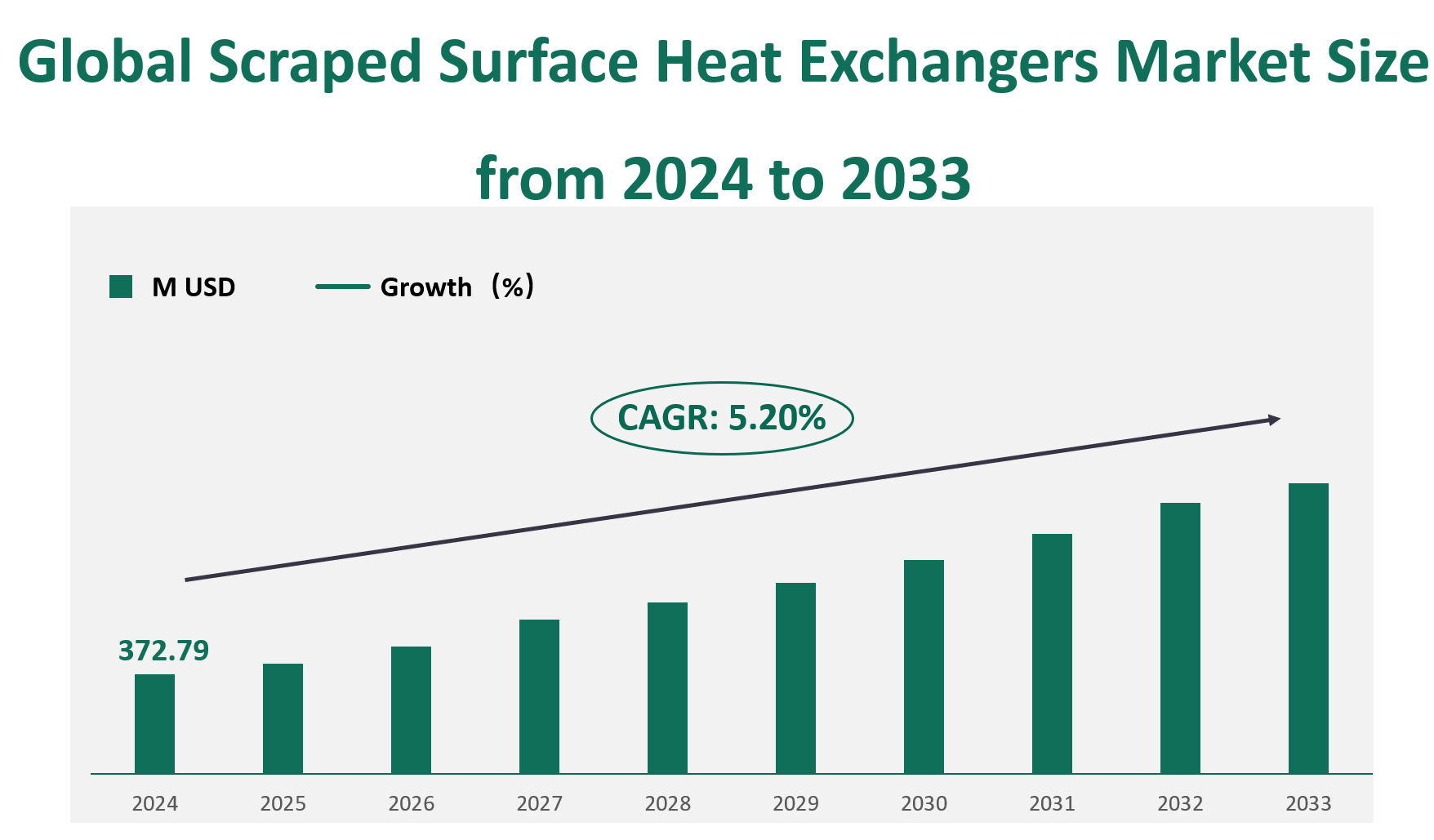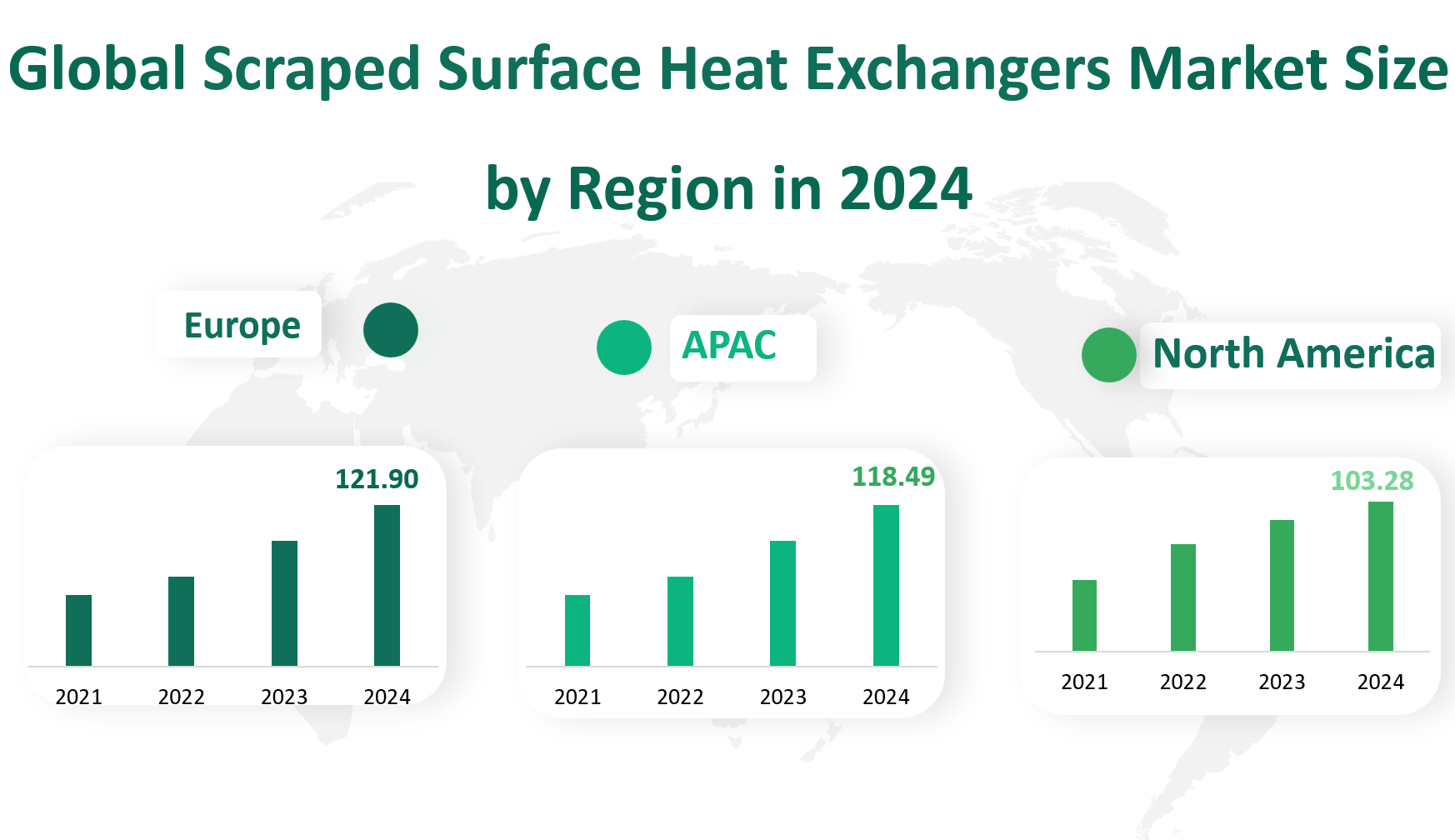1. Global Scraped Surface Heat Exchangers Market Insight Analysis
In 2024, the global Scraped Surface Heat Exchangers market is projected to reach a revenue of $372.79 million, with a Compound Annual Growth Rate (CAGR) of 5.20% from 2024 to 2033.
Scraped Surface Heat Exchangers (SSHEs) are specialized industrial devices designed to efficiently transfer heat between two fluids while maintaining optimal process conditions. These exchangers utilize rotating blades to continuously scrape the heat transfer surface, ensuring efficient heat exchange and preventing fouling. SSHEs are particularly effective in handling viscous fluids and materials with high solid content, making them indispensable in industries such as food and beverage, pharmaceuticals, and chemicals.
The basic function of SSHEs is to heat or cool viscous fluids, which is crucial in processes like crystallization, pasteurization, and cooling of high-viscosity products. They are designed to handle products that may settle or stratify, ensuring uniform temperature control and maintaining the integrity of delicate materials. For instance, in the food industry, SSHEs are used to melt and temper chocolate, ensuring precise temperature control and achieving the desired texture and consistency. In the pharmaceutical industry, they facilitate the production of uniform pharmaceuticals by quickly heating and instantaneously cooling liquid pharmaceuticals containing particles or heat-sensitive substances.
Figure Global Scraped Surface Heat Exchangers Market Size (M USD) and CAGR (2024-2033)

2. Driving and Limiting Factors of Scraped Surface Heat Exchangers Market Growth
The growth of the Scraped Surface Heat Exchangers market is driven by several key factors. The increasing demand from the food and beverage industry is a significant driver, as these exchangers are essential for processing viscous and temperature-sensitive materials like chocolate, dairy products, and sauces. The global food and beverage market’s expansion creates more opportunities for SSHEs, as they are widely used in heat transfer, crystallization, and other continuous processes in the dairy, chemical, paper, and pulp industries.
Another driving factor is the growing adoption of SSHEs in the pharmaceutical and biotechnology industries. These industries require precise temperature control and uniform mixing and crystallization, which SSHEs can provide. This trend is conducive to downstream pharmaceutical companies producing more high-quality and standardized drugs.
However, the market also faces several challenges. The instability of raw material prices, such as stainless steel, carbon steel, and alloys, impacts production costs. Rising raw material prices increase production costs, compress profit margins, and put pressure on the production and operation of enterprises. Additionally, SSHEs require certain maintenance costs due to potential sealing problems and the need for regular inspection and maintenance.
The installation accuracy of SSHEs significantly affects their performance, and improper installation can lead to decreased heat exchange efficiency or even failures. Furthermore, the power consumption of SSHEs is relatively high, increasing operating costs and posing economic considerations for enterprises.
3. Technology Innovation and Corporate Mergers and Acquisitions in Scraped Surface Heat Exchangers Market
The Scraped Surface Heat Exchangers market is characterized by continuous technological innovation and strategic corporate activities. Manufacturers are increasingly focusing on providing customized solutions to meet specific customer requirements. This includes designing and manufacturing new SSHEs based on product size, capacity, and specific application functions. For example, some new SSHEs use environmentally friendly CO2 refrigerant, which is more efficient and cost-effective than traditional ammonia refrigerants while meeting environmental protection requirements.
Corporate mergers and acquisitions are also shaping the market landscape. For instance, in 2021, HRS Heat Exchangers was acquired by Exchanger Industries Limited, a Canadian market leader in heat transfer products. This acquisition expanded HRS’s capabilities and market reach, enhancing its position in the global SSHE market.
4. Global Scraped Surface Heat Exchangers Market Size by Type
Scraped Surface Heat Exchangers (SSHEs) are specialized industrial devices designed to efficiently transfer heat between two fluids, particularly in applications involving viscous materials or processes requiring continuous operation. These devices utilize rotating blades to remove liquid from the heat transfer surface, ensuring efficient heat exchange. The two primary types of SSHEs are vertical and horizontal, each with distinct characteristics and applications.
Vertical SSHEs are typically designed in a vertical cylindrical configuration. They are particularly effective in processes where gravity aids product flow, such as cooling or heating viscous liquids and crystallization processes. These exchangers are commonly used in the food industry for products like sauces, creams, and dairy products. The vertical orientation of these devices makes them efficient in handling products that may settle or stratify and also simplifies cleaning processes. In 2024, the market revenue for vertical SSHEs is projected to be $148.91 million.
Horizontal SSHEs, on the other hand, are designed in a horizontal cylindrical configuration. They are well-suited for continuous processes and are often used in industries such as chemicals, pharmaceuticals, and food processing. Applications include the production of products like chocolate, peanut butter, and other viscous substances. Horizontal SSHEs are designed to handle continuous operations and are particularly effective in processes that require precise temperature control and uniform mixing. In 2024, the market revenue for horizontal SSHEs is projected to be $223.87 million.
Table Global Scraped Surface Heat Exchangers Market Size by Type in 2024
5. Global Scraped Surface Heat Exchangers Market Size by Application
Scraped Surface Heat Exchangers are utilized across various industries due to their ability to efficiently manage heat transfer in processes involving viscous and temperature-sensitive materials. The primary applications include the chemical industry, food and beverage industry, pharmaceuticals, and others.
In the chemical industry, SSHEs play a crucial role in crystallization processes. They are used to heat or cool viscous fluids with high viscosity and large solid particles, facilitating the production of fine chemicals and specialty product crystals. The precise temperature control offered by SSHEs ensures consistent product quality and efficiency in chemical processes. In 2024, the market revenue for SSHEs in the chemical industry is projected to be $95.51 million.
The food and beverage industry is one of the largest consumers of SSHEs. These devices are used for processes such as melting and tempering chocolate, ensuring precise temperature control to achieve the desired texture and consistency. SSHEs are also used to maintain the quality and integrity of delicate foods like cheese, yogurt, ice cream, pâté, and products containing whole fruit or vegetables. The ability to handle viscous and temperature-sensitive materials makes SSHEs indispensable in this industry. In 2024, the market revenue for SSHEs in the food and beverage industry is projected to be $217.65 million.
In the pharmaceutical industry, SSHEs achieve precise temperature control, which is essential for the production of uniform pharmaceuticals. They are used to quickly heat and instantaneously cool liquid pharmaceuticals containing particles or heat-sensitive substances, preventing scaling and retaining key nutritional or pharmaceutical ingredients. The reliability and precision of SSHEs make them critical in pharmaceutical manufacturing processes. In 2024, the market revenue for SSHEs in the pharmaceutical industry is projected to be $34.67 million.
Table Global Scraped Surface Heat Exchangers Market Size by Application in 2024
Application | Market Size (M USD) 2024 |
Chemical | 95.51 |
Food & Beverage | 217.65 |
Pharmaceuticals | 34.67 |
Others | 24.96 |
6. Global Scraped Surface Heat Exchangers Market by Top Regions
North America is expected to achieve a revenue of $103.28 million in 2024. This region has been a traditional stronghold for SSHEs, driven by the presence of key manufacturers and a robust industrial base. The market in North America is characterized by high demand from the food and beverage industry, as well as the pharmaceutical sector. The region benefits from advanced technological capabilities and stringent regulatory standards, which drive the adoption of efficient and high-quality SSHEs.
Europe is anticipated to generate a revenue of $121.90 million in 2024. Europe holds the largest market share globally, driven by the presence of several leading manufacturers and a diverse industrial landscape. The region’s strength in the food and beverage industry, coupled with its advanced manufacturing capabilities, makes it a significant market for SSHEs. The European market is also influenced by stringent environmental and safety regulations, which encourage the adoption of energy-efficient and sustainable heat exchange solutions.
Asia Pacific is projected to achieve a revenue of $118.49 million in 2024. This region is experiencing rapid growth, driven by the expanding food and beverage industry, increasing urbanization, and growing demand for processed foods. The market in Asia Pacific is characterized by high demand for SSHEs in applications such as chocolate production, dairy processing, and pharmaceutical manufacturing. The region’s growth is also supported by technological advancements and increasing investment in industrial infrastructure.
Latin America is expected to generate a revenue of $16.42 million in 2024. The market in this region is growing steadily, driven by increasing industrialization and demand from the food and beverage sector. Latin America benefits from a growing middle class and increasing investment in manufacturing capabilities, which drive the adoption of SSHEs for various industrial applications.
Middle East & Africa is projected to achieve a revenue of $12.70 million in 2024. The market in this region is influenced by growing demand from the food and beverage industry, as well as increasing investment in industrial infrastructure. The region’s growth is also supported by technological advancements and increasing focus on energy efficiency and sustainability.
Figure Global Scraped Surface Heat Exchangers Market Size by Region in 2024

7. Global Scraped Surface Heat Exchangers Market Analysis by Major Players
7.1 SPX Flow
Company Introduction and Business Overview: SPX Flow is a global leader in the design and manufacture of engineered flow components and process equipment. Established in 2015, the company operates primarily in North America, Europe, and Asia Pacific. SPX Flow offers a wide range of products, including pumps, valves, agitators, filters, and heat exchangers.
Products: SPX Flow’s SSHEs include the Votator® II Horizontal Scraped Surface Heat Exchangers, which are designed for efficient and continuous processing. These exchangers are ideal for applications in the food and beverage industry, such as chocolate production and dairy processing.
Sales Revenue in 2024: $124.35 million
7.2 Alfa Laval
Company Introduction and Business Overview: Alfa Laval is a Swedish company with a long history dating back to 1883. The company specializes in high-speed separators, food systems, food heat transfer, centrifuges, and hygienic fluid handling technologies. Alfa Laval operates primarily in Europe and North America.
Products: Alfa Laval’s SSHEs include the Contherm® scraped-surface heat exchangers, which are designed to handle sticky, heat-sensitive, crystallizing, or viscous products. These exchangers are widely used in the food, chemical, and pharmaceutical industries.
Sales Revenue in 2024: $112.01 million
7.3 ProXES (Terlet)
Company Introduction and Business Overview: ProXES (Terlet) is a leading manufacturer of quality food processing machinery and systems. The company operates primarily in Europe, North America, and Asia. ProXES combines innovative and long-standing expert knowledge to provide comprehensive solutions for the food, pharmaceutical, cosmetics, and chemical industries.
Products: ProXES (Terlet) offers SSHEs with capacities up to 10,000 kg/hour, suitable for applications such as pasteurization, cooling, heating, crystallization, and cooking. These exchangers are ideal for processing soups, sauces, dairy products, and confectionery.
Sales Revenue in 2024: $15.22 million

